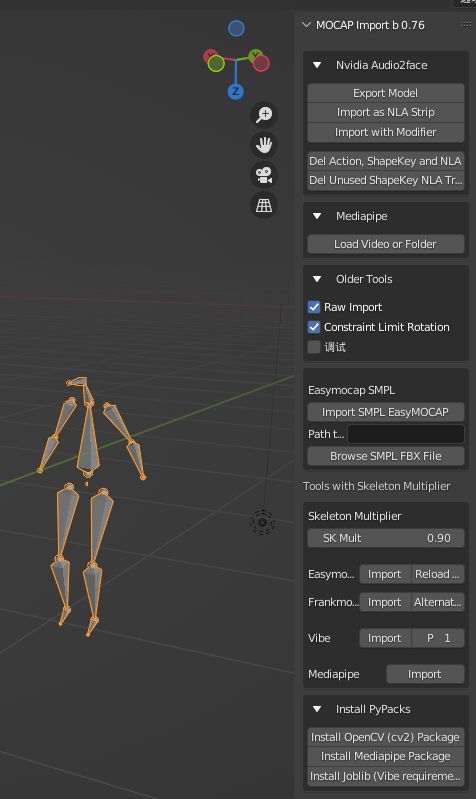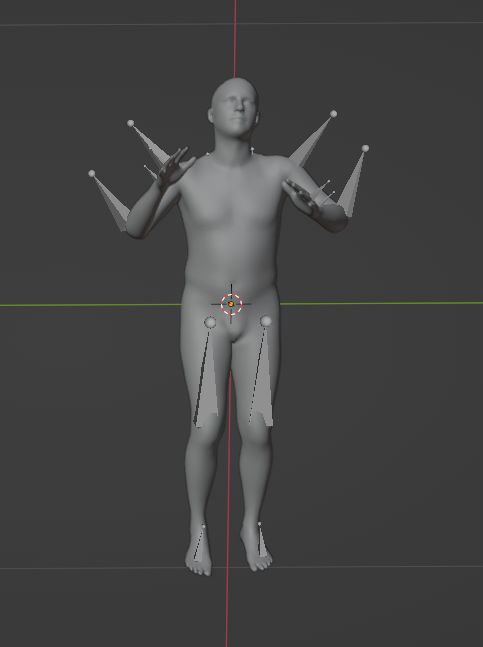由frankmocap得到的.pkl文件转为.bvh或者.fbx
需求
由Frankmocap所得到的.pkl文件转为blender里的.bvh或者Maya里的.fbx
Frankmocap_github项目地址
2D转3D转.bvh可以看VideoTo3dPoseAndBvh,.bvh转3D相对来说好转一点毕竟.bvh中的关节点与关节点组成的向量有这6自由度信息,但是3D点只有3自由度要转.bvh就要限制自由度。
问题
1.到2022年5月9号为止项目原作者还没有更新这一功能,即提供一个blender的addon;
2.第三方作者魔改了很多相关的插件,可以为EasyMocap,Vibe,Frankmocap等提供blender接口;然而很多可能满足smpl需求却不满足smplx需求;
3.blender里的python环境,package的安装相关教程较少,官方文档又不想看。
相关 1
第三方addon,这个小哥做了一个addon,基于VIBE改的(VIBE里由.pkl转.bvh的工作),但是这个插件偏向于EasyMocap相关功能较多,我导入frankmocap的pkl发现blender里只能生成14个点;在原Frankmocap项目的issue里可以找到这个小哥的很多评论,不会的也可以联系他;
编辑—>偏好设置---->安装addon即安装zip---->N调出addon界面---->导入mocap目录(内含一个视频extract出的很多.pkl)

相关 2
第二个忘记是哪找的了,是一个python文件fbx_output_FRANKMOCAP.py,这个程序里面导入模块import bpy,很明显是要在blender里面运行的;blender用python是真的不友好,要去看官方手册,里面的python控制台我不知道有什么用。。。。而且不同版本的blender也不一样会报很多奇怪的错误。
环境
ubuntu + blender3.1.2稳定版;
下载文件
需要一个SMPL_unity_v.1.0.0.zip文件(可以去SMPL作者官网那里下载),解压后放到VIBE项目下,把fbx_output_FRANKMOCAP.py插件放到VIBE项目下的lib/utils下面,原项目的环境不用配,只需要配置插件里的环境就好了,配置方法如下;
安装package
只要把要的包放到blender目录下的site-packages里就好了,我的操作是自己建一个和blender的python版本一样的conda虚拟环境,然后进到环境里用pip install packages -t directory命令装到blender目录下的site-packages里;
运行
运行脚本或者.py文件可以输入以下命令:./blender --python ~/Desktop/VIBE_pkl2fbx/lib/utils/fbx_output_FRANKMOCAP.py,原文件是有argparse命令行参数的,我不知道通过blender环境怎么输入,就直接改了原代码,把要输入的参数都直接修改好了,如果有人要用代码的话得自己改一下里面的路径和参数。最终可以在blender里导出.bvh或者.fbx文件。
Blender Python API中文介绍
blender的用法(ubuntu)
1.可以直接命令行下载安装,也可以去官网下载压缩包解压,我是解压的;
2.Blender左下角可以调出时间线功能,一般.bvh和.fbx都是一段骨骼或者蒙皮的动画,时间线可以播放动作;
3.找到blender安装目录下的bin下面的python解释器,用ubuntu终端输入命令行./python3.10可以进到blender解释器里,虽然好像没什么用;
4.blender软件里的python控制台是已经进到他那个python环境里了,在这里也运行不了啥程序,除了bpy模块下的函数我不知有什么其他作用。这时候有两种方法:第一种就是用scripting去打开.py文件再运行;第二种就是使用Ubuntu的终端,首先来到blender安装目录,运行./blender就可以打开这个软件(双击图标也可以),运行脚本或者.py文件可以输入以下命令:./blender --python directory.py。
5.blender肯定可以通过IDE或者其他API来使用python,但是作者只想用一个工具就没有深入。
6.所有效果图其实是一段会动的视频和frankmocap对应的输入视频是一样的动作,缺点是在这个插件里手部点没有输出。
修改过后的代码
# -*- coding: utf-8 -*-
# Max-Planck-Gesellschaft zur Förderung der Wissenschaften e.V. (MPG) is
# holder of all proprietary rights on this computer program.
# You can only use this computer program if you have closed
# a license agreement with MPG or you get the right to use the computer
# program from someone who is authorized to grant you that right.
# Any use of the computer program without a valid license is prohibited and
# liable to prosecution.
#
# Copyright©2019 Max-Planck-Gesellschaft zur Förderung
# der Wissenschaften e.V. (MPG). acting on behalf of its Max Planck Institute
# for Intelligent Systems. All rights reserved.
#
# Contact: [email protected]
#
# Author: Joachim Tesch, Max Planck Institute for Intelligent Systems, Perceiving Systems
#
# Create keyframed animated skinned SMPL mesh from .pkl pose description
#
# Generated mesh will be exported in FBX or glTF format
#
# Notes:
# + Male and female gender models only
# + Script can be run from command line or in Blender Editor (Text Editor>Run Script)
# + Command line: Install mathutils module in your bpy virtualenv with 'pip install mathutils==2.81.2'
import os
import sys
import bpy
import time
import joblib
import argparse
import numpy as np
import addon_utils
from math import radians
from mathutils import Matrix, Vector, Quaternion, Euler
import pickle
import os.path
import pandas as pd
# Globals
male_model_path = '/home/dms/Desktop/VIBE_pkl2fbx/data/SMPL_unity_v.1.0.0/smpl/Models/SMPL_m_unityDoubleBlends_lbs_10_scale5_207_v1.0.0.fbx'
female_model_path = '/home/dms/Desktop/VIBE_pkl2fbx/data/SMPL_unity_v.1.0.0/smpl/Models/SMPL_f_unityDoubleBlends_lbs_10_scale5_207_v1.0.0.fbx'
fps_source = 30
fps_target = 30
gender = 'male'
start_origin = 1
bone_name_from_index = {
0 : 'Pelvis',
1 : 'L_Hip',
2 : 'R_Hip',
3 : 'Spine1',
4 : 'L_Knee',
5 : 'R_Knee',
6 : 'Spine2',
7 : 'L_Ankle',
8: 'R_Ankle',
9: 'Spine3',
10: 'L_Foot',
11: 'R_Foot',
12: 'Neck',
13: 'L_Collar',
14: 'R_Collar',
15: 'Head',
16: 'L_Shoulder',
17: 'R_Shoulder',
18: 'L_Elbow',
19: 'R_Elbow',
20: 'L_Wrist',
21: 'R_Wrist',
22: 'L_Hand',
23: 'R_Hand'
}
# Helper functions
# Computes rotation matrix through Rodrigues formula as in cv2.Rodrigues
# Source: smpl/plugins/blender/corrective_bpy_sh.py
def Rodrigues(rotvec):
theta = np.linalg.norm(rotvec)
r = (rotvec/theta).reshape(3, 1) if theta > 0. else rotvec
cost = np.cos(theta)
mat = np.asarray([[0, -r[2], r[1]],
[r[2], 0, -r[0]],
[-r[1], r[0], 0]])
return(cost*np.eye(3) + (1-cost)*r.dot(r.T) + np.sin(theta)*mat)
# Setup scene
def setup_scene(model_path, fps_target):
scene = bpy.data.scenes['Scene']
###########################
# Engine independent setup
###########################
scene.render.fps = fps_target
# Remove default cube
if 'Cube' in bpy.data.objects:
bpy.data.objects['Cube'].select_set(True)
bpy.ops.object.delete()
# Import gender specific .fbx template file
bpy.ops.import_scene.fbx(filepath=model_path)
# Process single pose into keyframed bone orientations
def process_pose(current_frame, pose, trans, pelvis_position):
if pose.shape[0] == 72:
rod_rots = pose.reshape(24, 3)
else:
rod_rots = pose.reshape(26, 3)
mat_rots = [Rodrigues(rod_rot) for rod_rot in rod_rots]
# Set the location of the Pelvis bone to the translation parameter
armature = bpy.data.objects['Armature']
bones = armature.pose.bones
# Pelvis: X-Right, Y-Up, Z-Forward (Blender -Y)
# Set absolute pelvis location relative to Pelvis bone head
bones[bone_name_from_index[0]].location = Vector((100*trans[1], 100*trans[2], 100*trans[0])) - pelvis_position
# bones['Root'].location = Vector(trans)
bones[bone_name_from_index[0]].keyframe_insert('location', frame=current_frame)
for index, mat_rot in enumerate(mat_rots, 0):
if index >= 24:
continue
bone = bones[bone_name_from_index[index]]
bone_rotation = Matrix(mat_rot).to_quaternion()
quat_x_90_cw = Quaternion((1.0, 0.0, 0.0), radians(-90))
quat_z_90_cw = Quaternion((0.0, 0.0, 1.0), radians(-90))
if index == 0:
# Rotate pelvis so that avatar stands upright and looks along negative Y avis
bone.rotation_quaternion = (quat_x_90_cw @ quat_z_90_cw) @ bone_rotation
else:
bone.rotation_quaternion = bone_rotation
bone.keyframe_insert('rotation_quaternion', frame=current_frame)
return
# Process all the poses from the pose file
def process_poses(
input_path,
gender,
fps_source,
fps_target,
start_origin,
person_id=1,
):
print('Processing: ' + input_path)
# comeco da alteracao que fiz
pkl_path = '/home/dms/Desktop/VIBE_pkl2fbx/data/mocap/'
list_dir = os.listdir(pkl_path)
s_list = sorted(list_dir)
append_data = (pd.DataFrame(pd.DataFrame.from_dict(pickle.load(open(pkl_path+s_list[0],'rb'))).pred_output_list[0]['pred_body_pose']))
for i in s_list:
if i == s_list[0]:
print('0')
next
else:
print(i)
frank_data = pickle.load(open(pkl_path+i,'rb'))
frank = pd.DataFrame.from_dict(frank_data)
if 'pred_body_pose' not in frank.columns:
next
frank_pose = pd.DataFrame(frank.pred_output_list[0]['pred_body_pose'])
append_data = append_data.append(frank_pose)
# print(append_data)
poses = append_data.to_numpy()
########## Fim da alteracao que fiz
# data = joblib.load(input_path)
# poses = data[person_id]['pose']
trans = np.zeros((poses.shape[0], 3))
if gender == 'female':
model_path = female_model_path
for k,v in bone_name_from_index.items():
bone_name_from_index[k] = 'f_avg_' + v
elif gender == 'male':
model_path = male_model_path
for k,v in bone_name_from_index.items():
bone_name_from_index[k] = 'm_avg_' + v
else:
print('ERROR: Unsupported gender: ' + gender)
sys.exit(1)
# Limit target fps to source fps
if fps_target > fps_source:
fps_target = fps_source
print(f'Gender: {gender}')
print(f'Number of source poses: {str(poses.shape[0])}')
print(f'Source frames-per-second: {str(fps_source)}')
print(f'Target frames-per-second: {str(fps_target)}')
print('--------------------------------------------------')
setup_scene(model_path, fps_target)
scene = bpy.data.scenes['Scene']
sample_rate = int(fps_source/fps_target)
scene.frame_end = (int)(poses.shape[0]/sample_rate)
# Retrieve pelvis world position.
# Unit is [cm] due to Armature scaling.
# Need to make copy since reference will change when bone location is modified.
bpy.ops.object.mode_set(mode='EDIT')
pelvis_position = Vector(bpy.data.armatures[0].edit_bones[bone_name_from_index[0]].head)
bpy.ops.object.mode_set(mode='OBJECT')
source_index = 0
frame = 1
offset = np.array([0.0, 0.0, 0.0])
while source_index < poses.shape[0]:
print('Adding pose: ' + str(source_index))
if start_origin:
if source_index == 0:
offset = np.array([trans[source_index][0], trans[source_index][1], 0])
# Go to new frame
scene.frame_set(frame)
process_pose(frame, poses[source_index], (trans[source_index] - offset), pelvis_position)
source_index += sample_rate
frame += 1
return frame
def export_animated_mesh(output_path):
# Create output directory if needed
output_dir = os.path.dirname(output_path)
if not os.path.isdir(output_dir):
os.makedirs(output_dir, exist_ok=True)
# Select only skinned mesh and rig
bpy.ops.object.select_all(action='DESELECT')
bpy.data.objects['Armature'].select_set(True)
bpy.data.objects['Armature'].children[0].select_set(True)
if output_path.endswith('.glb'):
print('Exporting to glTF binary (.glb)')
# Currently exporting without shape/pose shapes for smaller file sizes
bpy.ops.export_scene.gltf(filepath=output_path, export_format='GLB', export_selected=True, export_morph=False)
elif output_path.endswith('.fbx'):
print('Exporting to FBX binary (.fbx)')
bpy.ops.export_scene.fbx(filepath=output_path, use_selection=True, add_leaf_bones=False)
else:
print('ERROR: Unsupported export format: ' + output_path)
sys.exit(1)
return
if __name__ == '__main__':
try:
if bpy.app.background:
parser = argparse.ArgumentParser(description='Create keyframed animated skinned SMPL mesh from VIBE output')
parser.add_argument('--input', dest='input_path', type=str, required=True,
help='Input file or directory')
parser.add_argument('--output', dest='output_path', type=str, required=True,
help='Output file or directory')
parser.add_argument('--fps_source', type=int, default=fps_source,
help='Source framerate')
parser.add_argument('--fps_target', type=int, default=fps_target,
help='Target framerate')
parser.add_argument('--gender', type=str, default=gender,
help='Always use specified gender')
parser.add_argument('--start_origin', type=int, default=start_origin,
help='Start animation centered above origin')
parser.add_argument('--person_id', type=int, default=1,
help='Detected person ID to use for fbx animation')
args = parser.parse_args()
input_path = args.input_path
output_path = args.output_path
if not os.path.exists(input_path):
print('ERROR: Invalid input path')
sys.exit(1)
fps_source = 30
fps_target = 30
gender = 'male'
start_origin = 1
input_path = '~/Desktop/VIBE_pkl2fbx/data/mocap'
output_path = '~/Desktop/VIBE_pkl2fbx/data/output/output.fbx'
# end if bpy.app.background
startTime = time.perf_counter()
# Process data
cwd = os.getcwd()
# Turn relative input/output paths into absolute paths
# if not input_path.startswith(os.path.sep):
# input_path = os.path.join(cwd, input_path)
#
# if not output_path.startswith(os.path.sep):
# output_path = os.path.join(cwd, output_path)
print('Input path: ' + input_path)
print('Output path: ' + output_path)
if not (output_path.endswith('.fbx') or output_path.endswith('.glb')):
print('ERROR: Invalid output format (must be .fbx or .glb)')
sys.exit(1)
# # Process pose file
# if input_path.endswith('.pkl'):
# if not os.path.isfile(input_path):
# print('ERROR: Invalid input file')
# sys.exit(1)
#
# poses_processed = process_poses(
# input_path=input_path,
# gender='male',
# fps_source=30,
# fps_target=30,
# start_origin=1,
# # person_id=args.person_id,
# person_id = 0
# )
# export_animated_mesh(output_path)
poses_processed = process_poses(
input_path=input_path,
gender='male',
fps_source=30,
fps_target=30,
start_origin=1,
# person_id=args.person_id,
person_id=0
)
export_animated_mesh(output_path)
print('--------------------------------------------------')
print('Animation export finished.')
print(f'Poses processed: {str(poses_processed)}')
print(f'Processing time : {time.perf_counter() - startTime:.2f} s')
print('--------------------------------------------------')
sys.exit(0)
except SystemExit as ex:
if ex.code is None:
exit_status = 0
else:
exit_status = ex.code
print('Exiting. Exit status: ' + str(exit_status))
# Only exit to OS when we are not running in Blender GUI
if bpy.app.background:
sys.exit(exit_status)
相关 3
同是Facebook研究院出品的fairmotion项目里主要提供smpl和bvh格式相互之间的转化和其他很多tasks,但是项目文档说明较少,几乎全是接口函数,如果想对应自己的需求的话需要自己去看里面函数的定义。
环境
这个环境十分好配,采取以下两种方法都可以,只不过由于human_body_prior库有改动,会出现一些小问题,问题出来再改就行了。

运行
代码路径fairmotion/fairmotion/data/frankmocap.py 下的原代码运行后会报ValueError: could not broadcast input array from shape (8,3,3) into shape (1,3,3)问题我没有解决,用的是另外一个代码,而且需要对frankmocap得到的很多pkl进行一个处理合并为一个pkl。处理好之后就可以运行frankmocap.py文件从smpl数据格式转到bvh格式了。
数据预处理代码:
# frankdata_preprocess.py
import os
import pickle
import os.path as op
processed_data = []
root = r'./frankmocap_output/mocap'
for name in sorted(os.listdir(op.join(root))):
file_path = op.join(root, name)
preprocess_data = pickle.load(open(file_path, 'rb'))
motion_key = list(preprocess_data.keys())[6]
motion_data = preprocess_data[motion_key] # 找到'pred_output_list'键对应的值,[{}]
processed_data.append(motion_data) # [[{}], [{}], [{}]]
pickle.dump(processed_data, open(r'./frankmocap_output/processed_data.pkl', 'wb'))
frankmocap2bvh代码:
# Copyright (c) Facebook, Inc. and its affiliates.
# fairmotion/fairmotion/data/frankmocap.py
import numpy as np
import pickle
import torch
from fairmotion.data import amass, bvh
from fairmotion.core import motion as motion_classes
from fairmotion.utils import constants, utils
from fairmotion.ops import conversions, motion as motion_ops
def get_smpl_base_position(bm, betas):
pose_body_zeros = torch.zeros((1, 3 * (22 - 1)))
body = bm(pose_body=pose_body_zeros, betas=betas)
base_position = body.Jtr.detach().numpy()[0, 0:22]
return base_position
def compute_im2sim_scale(
joints_img,
base_position,
):
left_leg_sim = np.linalg.norm(
base_position[amass.joint_names.index("lknee")] - base_position[amass.joint_names.index("lankle")])
# indices from from frankmocap.bodymocap.constants
left_leg_img = np.linalg.norm(joints_img[29][:2] - joints_img[30][:2])
right_leg_sim = np.linalg.norm(
base_position[amass.joint_names.index("rknee")] - base_position[amass.joint_names.index("rankle")])
right_leg_img = np.linalg.norm(joints_img[25][:2] - joints_img[26][:2])
return (left_leg_sim + right_leg_sim) / (left_leg_img + right_leg_img)
def load(
file,
motion=None,
bm_path=None,
motion_key=None,
estimate_root=False,
scale=1.0,
load_skel=True,
load_motion=True,
v_up_skel=np.array([0.0, 1.0, 0.0]),
v_face_skel=np.array([0.0, 0.0, 1.0]),
v_up_env=np.array([0.0, 1.0, 0.0]),
):
processed_data = pickle.load(open(file, "rb"))
# if motion_key is None:
# motion_key = list(all_data.keys())[6] # 找到'pred_output_list'键对应的值
motion_data = processed_data
bm = amass.load_body_model(bm_path)
betas = torch.Tensor(np.array(motion_data[0][0]["pred_betas"])[:]).to("cpu")
# img_shape = motion_data[0]["pred_output_list"][0]["img_shape"]
num_joints = len(amass.joint_names)
skel = amass.create_skeleton_from_amass_bodymodel(bm, betas, len(amass.joint_names), amass.joint_names)
joint_names = [j.name for j in skel.joints]
num_frames = len(motion_data)
print(num_frames)
T = np.random.rand(num_frames, num_joints, 4, 4)
T[:] = constants.EYE_T
# Use lowest point of right/left ankle from first image frame as reference
ref_root_y = np.min((
motion_data[0][0]["pred_joints_img"][25][1],
motion_data[0][0]["pred_joints_img"][30][1]
))
for i in range(num_frames):
for j in range(num_joints):
T[i][joint_names.index(amass.joint_names[j])] = conversions.R2T(
np.array(motion_data[i][0]["pred_rotmat"][0])[j]
)
if estimate_root:
R_root = conversions.T2R(T[i][0])
p_root = np.zeros(3)
base_position = get_smpl_base_position(bm, betas)
# compute scale as ratio of limb length in img and bm
im2sim_scale = compute_im2sim_scale(
motion_data[i][0]["pred_joints_img"],
base_position,
)
p_root[0] = np.mean((
motion_data[i][0]["pred_joints_img"][27][0],
motion_data[i][0]["pred_joints_img"][28][0]
)) * im2sim_scale
root_y = np.mean((
motion_data[i][0]["pred_joints_img"][27][1],
motion_data[i][0]["pred_joints_img"][28][1]
))
p_root[2] = (ref_root_y - root_y) * im2sim_scale
# p_root[1] = np.max((
# np.linalg.norm(T[i][amass.joint_names.index("root")] - T[i][amass.joint_names.index("lankle")]),
# np.linalg.norm(T[i][amass.joint_names.index("root")] - T[i][amass.joint_names.index("rankle")]),
# ))
# print(p_root[1])
T[i][0] = conversions.Rp2T(R_root, p_root)
motion = motion_classes.Motion.from_matrix(T, skel)
motion.set_fps(60)
motion = motion_ops.rotate(
motion,
conversions.Ax2R(conversions.deg2rad(-90)),
)
# post process to ensure character stays above floor
positions = motion.positions(local=False)
for i in range(motion.num_frames()):
ltoe = positions[i][amass.joint_names.index("ltoe")][2]
rtoe = positions[i][amass.joint_names.index("rtoe")][2]
offset = min(ltoe, rtoe)
if offset < 0.05:
# print(offset)
R, p = conversions.T2Rp(T[i][0])
p[2] += 0.05 - offset
T[i][0] = conversions.Rp2T(R, p)
motion = motion_classes.Motion.from_matrix(T, skel)
motion = motion_ops.rotate(
motion,
conversions.Ax2R(conversions.deg2rad(-90)),
)
return motion
if __name__ == '__main__':
file = r'../../daoboke/frankmocap_output/processed_data.pkl'
motion = load(file=file, bm_path=r'../../body_models/smplh/neutral/model.npz')
bvh.save(motion, filename=r'../../daoboke/frankmocap_output/output.bvh')
如果想要简单的从一般的smpl格式数据转到bvh的话,可以在fairmotion项目中运行以下代码,然而在fairmotion中我未能成功完成bvh2smpl代码:
# smpl2bvh.py
import torch
from human_body_prior.body_model.body_model import BodyModel
from fairmotion.data import amass, bvh
def load_body_model(bm_path, num_betas=10, model_type="smplh"):
comp_device = torch.device("cpu")
bm = BodyModel(
bm_path=bm_path,
num_betas=num_betas,
model_type=model_type
).to(comp_device)
return bm
# Load file
file = './smplData/DanceDB/20120731_StefanosTheodorou/Stefanos_1os_antrikos_karsilamas_C3D_poses.npz'
bm_path = '../body_models/smplh/{}/model.npz'.format('male')
num_betas = 10 # body parameters
model_type = 'smplh'
bm = load_body_model(bm_path, num_betas, model_type)
motion = amass.load(file, bm, bm_path)
bvh.save(motion, filename='./smplData/output.bvh')
